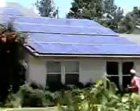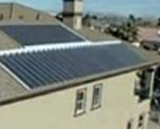Getting the Most out of Home Solar Panels: Designing Arrays and Maintaining Solar Panels
Home solar panels are maintenance free-almost. A well installed solar energy system with home solar panels can deliver hands-free operation for up to 25 years. Hands-free meaning you don't need to change the oil, maintain moving parts, or apply a coat of paint after a period of time. But your solar energy system will degrade with the passage of time, and its output at 20 years will not be as it was at 5 years. Are there things you can do to keep those panels producing at their optimum level? In a nutshell, yes. The performance of your system is affected by the following factors: sunlight intensity; cell material; load resistance; cell temperature; shading. We will talk about each of these factors in this learning article.
Siting Your Home Solar Panels
The first thing you can do to ensure long, productive life of your system is by picking the best site you can for the array. Sometimes this is obvious and other times not quite as clear. Every solar array is unique and the name of the game is positioning your array so the panels are perpendicular to the sun for as long as possible during the day. In the U.S. this means pointing them south and tilting them at the latitude of your location. The continental U.S. is roughly between 25º and 50º (San Antonio is 29º degrees and Minneapolis is 44º) latitude, so your array will likely tilt at an angle in this range.
Most installations are less than ideal for one reason or another. Your main goal is to position the solar modules as best you can within the constraints of your property. Since the sun crosses the southern portion of our sky (in the northern hemisphere), south facing panels will reap the most sun hours, or sunlight intensity, and produce the most power.
Related: Solar Panels Produce Financial and Environmental Benefits
Choosing Your Home Solar Panels
The next thing you can do to make your solar modules work for you is by choosing the right solar module for your array. If you haven't installed an array before, check out our updated solar panel comparison. Most important is the cell material of the module, its efficiency, and its rated power values. If you're going to invest in a solar energy system - have some fun with it! Manufacturers work very hard at efficiency gains and you might as well know what you're buying. Crystalline silicon is the material that makes up the bread and butter of our product line, and mono-crystalline modules are the most efficient (and usually the most expensive). Review the spec sheets and learn something about solar module efficiencies before you buy. You can quickly narrow your choice to 3 or 4 modules.

Related:
Solar Panel Efficiency: Have you checked your eta lately?
Load Resistance of Your Solar Array
Okay, so you have a good site, and you have a solar module, or maybe you already have an array that isn't producing very well. Know that grid-tie systems are typically more efficient than off-grid systems, due to the added load of battery charging. PV performance is directly impacted by the load the system is connected to. Tying your array directly to the grid eliminates the battery load - the more load you add to your panels the more their performance is impacted. If you're interested in the fastest payback, grid-tie systems are better thanks to fewer components (you won't need batteries) needed for the array, in addition to incentives available for grid-tie arrays.
Incentives aside, understand that the more load - or resistance - you put on an array the more the array will operate at higher voltages, and lower currents. Overloading an array forces it to operate at less than optimum voltage and current levels, or the sweet spot of the array.
Hotter is Not Better for Your Home Solar Panels
In addition to site selection, cell material and load variables, module performance varies with temperature. The ideal temperature for solar modules is 25ºC or 77ºF. Every degree centigrade above this level reduces the voltage level typically by .5%/ºC. So at 26ºC (78.8ºF) a 30-volt module will only deliver 28.5 volts! As modules heat up through the course of the day, their overall power (watts) can lessen. Conversely, every degree below 25ºC a module's voltage increases by this same percentage. Cold, clear days are ideal for solar power production! Hot humid days are not very optimal. For this reason it is important to ensure sufficient ventilation for your solar array. 
Tightly mounted flush mount systems can be less productive than the same solar panels mounted with 3-inch standoffs. Why? A tightly mounted array provides less ventilation than one standing off just a couple of inches. Consider using a 3-inch standoff on your roof instead of mounting it directly with L-feet. They're equally strong and a few watts of power over the course of many years can add up - like compound interest!
Shade is Not Your Home Solar Panel's Friend
Last but not least your array's performance is affected by shade. Shading can come in many forms - from trees, a chimney, plumbing vents, leaves falling, dust, snow, birds, you name it. Shade is anything that blocks out sun from the solar cell. The goal here is you want your solar panels shade free during the day. Sometimes shade can't be avoided, particularly as the sun moves lower on the horizon during the winter season.
Micro-inverters have made a big impact on the market - they can manage shading issues better than central inverters by the simple fact micro-inverters manage shading on the single-module level, instead of the entire array. The micro-inverters manage this challenge one panel at a time, so when a portion of the array is shaded, the other panels can still produce at their optimum level. What if you have a central solar inverter? Our recommendation is to visually inspect your array once or twice a year - at which time you can wipe it down, hose it off, or just sweep it off to remove accumulated dust and debris. Equally important is that you need to know whether your friendly birds, squirrels, or other critters are making warm nests between your roof and your solar array.
As you plan, build, and maintain your solar system keep these factors in mind. Picking a good site for your array is paramount! No amount of technological wizardry will overcome a north-facing array. Secondarily, the panels and system design employed can have a big impact on the overall output of the array. Flush-mounting an array in hot and humid climates can be a big performance drag on a system that would perform better if it were just a few inches off the roof. And as for shade - most shade can be avoided by picking a good site - unplanned shade can be managed by visually inspecting your array from time to time. Cleaning, brushing or spraying away the blocking material will keep those cells producing at their optimum level. Take pride in your solar energy system and it will serve you well.
